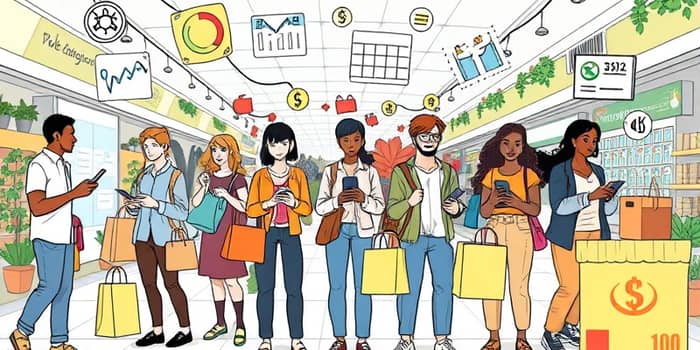
The modern marketplace is increasingly shaped by the collective strength of individual buyers. Waves of demographic shifts, technological innovation, and economic pressures have converged to elevate consumer influence. Today, purchasing behaviors do more than reflect tastes—they actively forge brand strategies and reshape entire industries. In this article, we delve into the most pressing trends, backed by data, to illuminate how consumer power is not just a concept but a driving force. By understanding these dynamics, businesses and consumers alike can navigate a rapidly evolving marketplace with confidence.
Global economic headwinds are moderating growth, and consumer spending is following suit. In the United States, nominal spending is projected to expand by 3.7% in 2025, falling from 5.7% in 2024, and decelerating further to 2.9% in 2026. Factors driving this slowdown include a cooling labor market, tariff-induced inflation, and heightened policy uncertainty. However, affluent buyers continue to dominate spending, underpinned by resilient balance sheets and continued willingness to invest in goods and experiences.
In a broader context, subdued lending rates and cautious credit management mean that ordinary households are making more deliberate choices. Inflationary pressures persist, prompting 40% of consumers to choose generic brands over national labels. As a result, businesses must reconcile margin protection with competitive pricing to retain market share.
Millennials and Gen Z wield disproportionate influence on market trends. With 60% of millennials and 58% of Gen Z willing to pay more for eco-friendly products, their purchasing power is redefining priorities for legacy brands and startups alike. Younger consumers also drive digital-first behaviors, embracing buy now, pay later flexibility and subscription services at higher rates. These cohorts demand authenticity, transparency, and brands that mirror their values, from vegan offerings to social justice support.
Conversely, urban consumers are particularly receptive to sustainable and locally sourced goods. Demographic segmentation now hinges on financial ability and environmental stance, compelling marketers to tailor messages to distinct audience layers. Affluent segments remain less sensitive to price hikes, whereas price-sensitive groups seek deals and loyalty rewards with renewed vigor.
In 2025, sustainability remains a major force across all markets. Approximately 58% of global shoppers express a willingness to invest more in eco-friendly items, and 60% of urban buyers are ready to pay premiums for green credentials. Brand transparency, carbon disclosures, and ethical supply chains have moved from marketing fluff to baseline expectations. Companies failing to address these demands risk alienating a sizable portion of their audience and diminishing long-term loyalty.
Meanwhile, secondary markets for secondhand goods experienced a slight dip, with only 11% of consumers purchasing preloved items online in the past week—a 24% drop since late 2021. Yet, the desire for brand accountability persists: 43% of consumers want clear environmental reporting and responsible sourcing from their favorite companies.
The pandemic accelerated a shift that shows no signs of slowing. E-commerce now accounts for 16.1% of all U.S. retail sales, compared to 11.8% before 2020. Businesses are channeling investment into digital channels, direct-to-consumer strategies, and logistics that support seamless experiences. In 2020, global giants like Nestlé reported a 49% year-over-year uptick in online sales, cementing e-commerce as a profit center rather than a novelty.
Brands that excel offer consistent messaging and frictionless returns across all touchpoints. Omnichannel strategies, coupled with data-driven personalization, allow companies to meet elevated expectations and bolster retention.
Inflation has reshaped the value equation for many households. With prices rising, 78% of consumers strategically consolidate purchases and chase deals, promotions, and loyalty points. Discount grocery chains have flourished, as 40% of shoppers swap household names for store brands. Bundled offerings, time-limited coupons, and membership perks have become potent tools for moving volume without eroding profitability.
These tactics offer consumers a sense of control in uncertain times and give brands an opportunity to nurture lasting relationships through value-added services.
In an era where choice is infinite, brand loyalty is under intense scrutiny. Over half of all consumers reduce spending after a negative experience. Strikingly, improving customer experience ratings from 1–2 stars to 3 stars can boost repeat purchases by 68% and recommendation likelihood by 97%. Consumers expect hyper-personalized interactions that anticipate needs, resolve issues swiftly, and reward repeat engagement.
Segmentation by purchasing power enhances this personalization. Affluent customers often receive premium treatment through exclusive offers and early access, while budget-conscious segments benefit from targeted discounts. Advanced analytics and AI-powered dashboards are now essential for anticipating consumer intent and tailoring offers in real time.
Subscription services and alternative payment models are surging as consumers prioritize flexibility. Leisure and entertainment subscriptions are rebounding post-pandemic, reflecting pent-up demand for experiences. Digital media, fitness memberships, and curated product boxes drive consistent revenue streams and deepen customer bonds.
These offerings provide predictable cash flow for businesses and empower consumers to budget more effectively, strengthening brand-consumer ties over the long term.
Despite abundant opportunities, brands face persistent headwinds. Supply chain disruptions continue to test agility, while inflationary pressures erode consumer confidence. Companies must balance margin protection with competitive pricing, all while meeting smooth, low-friction returns and personalization demands. Technological investments in logistics, AI, and cyber resilience are non-negotiable to maintain service levels and trust.
Looking ahead, consumer power will only intensify. Shoppers are more informed, interconnected, and values-driven than ever before. Brands that pivot quickly, engage authentically, and deliver consistent, high-quality experiences will capture loyalty and market share. In contrast, complacency and misaligned strategies risk irrelevance in an unforgiving landscape.
Ultimately, understanding spending trends is not an academic exercise but a strategic imperative. By decoding consumer signals and aligning with evolving expectations, businesses can not only survive but thrive, harnessing the very power that consumers wield. As we enter a new chapter of market evolution, the most successful players will be those who see buyers not as mere transaction partners, but as powerful architects of tomorrow’s economy.
References













